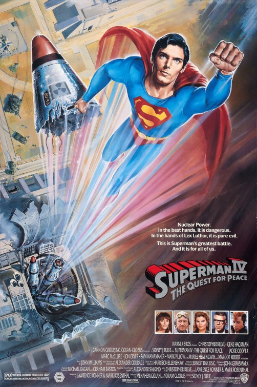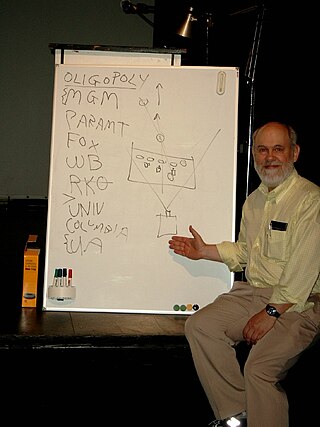Related Research Articles

David O. Selznick, born as David Selznick was an American film producer, screenwriter and film studio executive who produced Gone with the Wind (1939) and Rebecca (1940), both of which earned him an Academy Award for Best Picture. He also won the Irving Thalberg Award at the 12th Academy Awards, Hollywood's top honor for a producer, in recognition of his shepherding Gone with the Wind through a long and troubled production and into a record-breaking blockbuster.

Richard Lester Liebman is an American retired film director based in the United Kingdom, famous for his comedic and campy tone style of shooting movies and for his work in both USA and UK cinema.
Development hell, also known as development purgatory or development limbo, is media and software industry jargon for a project, concept, or idea that remains in a stage of early development for a long time, because the project is stuck in legal, technical, or artistic challenges. A work may move between many sets of artistic leadership, crews, scripts, game engines, or studios. Many projects which end up in development hell never progress into production, and are gradually abandoned by the involved parties.

Superman is a 1978 superhero film based on the DC Comics superhero Superman, played by Christopher Reeve. It is the first of four installments in the Superman film series starring Reeve as Superman. The film was directed by Richard Donner based on a screenplay by Mario Puzo, David Newman, Leslie Newman, and Robert Benton. In addition to Reeve, the film features an ensemble cast including Marlon Brando, Gene Hackman, Jeff East, Margot Kidder, Glenn Ford, Phyllis Thaxter, Jackie Cooper, Trevor Howard, Marc McClure, Terence Stamp, Valerie Perrine, Ned Beatty, Jack O'Halloran, Maria Schell, and Sarah Douglas. It depicts the origin of Superman, including his infancy as Kal-El of Krypton, son of Jor-El (Brando), and his youthful years in the rural town of Smallville. Disguised as reporter Clark Kent, he adopts a mild-mannered disposition in Metropolis and develops a romance with Lois Lane (Kidder) while battling the villainous Lex Luthor (Hackman).

Richard Donner was an American film director and producer who directed some of the most financially successful films during the New Hollywood era. According to film historian Michael Barson, Donner was "one of Hollywood's most reliable makers of action blockbusters". His career spanned over 50 years, crossing multiple genres and filmmaking trends.

Superman IV: The Quest for Peace is a 1987 superhero film directed by Sidney J. Furie and written by Lawrence Konner and Mark Rosenthal from a story by Christopher Reeve, Konner, and Rosenthal based on the DC Comics character Superman. The film stars Reeve, Gene Hackman, Jackie Cooper, Marc McClure, Jon Cryer, Sam Wanamaker, Jim Broadbent, Mariel Hemingway, and Margot Kidder.
Filmmaking or film production is the process by which a motion picture is produced. Filmmaking involves a number of complex and discrete stages, starting with an initial story, idea, or commission. It then continues through screenwriting, casting, pre-production, shooting, sound recording, post-production, and screening the finished product before an audience that may result in a film release and an exhibition. Filmmaking occurs in a variety of economic, social, and political contexts around the world. It uses a variety of technologies and cinematic techniques.

Principal photography is the phase of producing a film or television show in which the bulk of shooting takes place, as distinct from the phases of pre-production and post-production.

Superman II is a 1980 superhero film directed by Richard Lester and written by Mario Puzo and David and Leslie Newman from a story by Puzo based on the DC Comics character Superman. It is the second installment in the Superman film series and a sequel to Superman (1978). It stars Gene Hackman, Christopher Reeve, Terence Stamp, Ned Beatty, Sarah Douglas, Margot Kidder, and Jack O'Halloran. The film was released in Australia and mainland Europe on December 4, 1980, and in other countries throughout 1981. Selected premiere engagements of Superman II were presented in Megasound, a high-impact surround sound system similar to Sensurround.
In filmmaking, dailies are the raw, unedited footage shot during the making of a motion picture. The term comes from when movies were all shot on film because usually at the end of each day, the footage was developed, synced to sound, and printed on film in a batch for viewing the next day by the director, selected actors, and film crew members. After the advent of digital filmmaking, "dailies" were available instantly after the take and the review process was no longer tied to the overnight processing of film and became more asynchronous. Now some reviewing may be done at the shoot, even on location, and raw footage may be immediately sent electronically to anyone in the world who needs to review the takes. For example, a director can review takes from a second unit while the crew is still on location or producers can get timely updates while travelling. Dailies serve as an indication of how the filming and the actors' performances are progressing. The term was also used to describe film dailies as "the first positive prints made by the laboratory from the negative photographed on the previous day".
Alexander Salkind was a Polish born-French film producer, the second of three generations of successful international producers.

Superboy is an American television series based on the fictional DC comic book character Superman's early years as Superboy. The show ran from 1988–1992 in syndication. It was renamed The Adventures of Superboy at the start of the third season.
Ilya Juan Salkind Domínguez, usually known as Ilya Salkind, is a Mexican film and television producer, known for his contributions to three of the four live-action Superman films of the 1970s and 1980s alongside his father, Alexander Salkind.

David Jay Bordwell is an American film theorist and film historian. Since receiving his PhD from the University of Iowa in 1974, he has written more than fifteen volumes on the subject of cinema including Narration in the Fiction Film (1985), Ozu and the Poetics of Cinema (1988), Making Meaning (1989), and On the History of Film Style (1997).

The Three Musketeers (also known as The Three Musketeers (The Queen's Diamonds)) is a 1973 swashbuckler film based on the 1844 novel by Alexandre Dumas. It is directed by Richard Lester from a screenplay by George MacDonald Fraser, and produced by Ilya Salkind. It stars Michael York, Oliver Reed, Frank Finlay, and Richard Chamberlain as the titular musketeers, with Raquel Welch, Geraldine Chaplin, Jean-Pierre Cassel, Charlton Heston, Faye Dunaway, Christopher Lee, Simon Ward, Georges Wilson and Spike Milligan.
Film budgeting refers to the process by which a line producer, unit production manager, or production accountant prepares a budget for a film production. This document, which could be over 130 pages long, is used to secure financing for and lead to pre-production and production of the film. Multiple drafts of the budget may be required to whittle down costs. A budget is typically divided into four sections: above the line, below the line, post-production, and other. The budget excludes film promotion and marketing, which is the responsibility of the film distributor. Film financing can be acquired from a private investor, sponsor, product placement, film studio, entertainment company, and/or out-of-pocket funds.

Superman II: The Richard Donner Cut is a 2006 re-edited director's cut of the 1980 superhero film Superman II. It is a sequel to Richard Donner's 1978 film Superman, based on the DC Comics superhero of the same name, and stars Gene Hackman, Christopher Reeve, and Marlon Brando, the latter whose scenes were removed and entirely re-shot with actress Susannah York for the theatrical release. This alternate cut was edited by Michael Thau and was overseen and completed by Donner himself. It features a significant amount of discarded footage, alternate takes, and story elements not featured in the theatrical version.

DC Comics's Superman franchise, based on the character of the same name created by Jerry Siegel and Joe Shuster in June 1938, has seen the release of various films since its inception. He debuted in cinemas in a series of animated shorts beginning in 1941, subsequently starring in two movie serials in 1948 and 1950. An independent studio, Lippert Pictures, released the first Superman feature film, Superman and the Mole Men, starring George Reeves, in 1951. In 1973, the film rights to the Superman character were purchased by Ilya Salkind, Alexander Salkind, and Pierre Spengler. After numerous scripts and years in development, Richard Donner was hired as their director, filming Superman (1978) and Superman II (1980) simultaneously. Donner had already shot eighty percent of Superman II with Christopher Reeve before it was decided to finish shooting the first film. The Salkinds fired Donner after Superman's release and commissioned Richard Lester as the director to finish Superman II. Lester also returned for Superman III (1983), and the Salkinds further produced the related 1984 spin-off Supergirl before selling the rights to Cannon Films, resulting in the poorly reviewed Superman IV: The Quest for Peace (1987). Ilya Salkind commissioned a fifth Superman script before Warner Bros. acquired the rights entirely in 1993.
Janet Staiger is the William P. Hobby Centennial Professor Emeritus of Communication in the Department of Radio-Television-Film and Professor Emeritus of Women's and Gender Studies at the University of Texas at Austin.

Lex Luthor is a supervillain portrayed by American-actor Gene Hackman in the Warner Bros. Superman film series produced by Ilya and Alexander Salkind, and is an adaption of the original DC Comics character, Lex Luthor. Luthor's girlfriend, film-original character Eve Teschmacher, was later adapted to comic books and other media.
References
- 1 2 3 4 Staiger, Janet (1985). "Chapter 26: The package-unit system: unit management after 1955". In Bordwell, David; Staiger, Janet; Thompson, Kristin (eds.). The Classical Hollywood Cinema: Film Style & Mode of Production to 1960. New York: Columbia University Press. p. 330. ISBN 9780231060554.
- 1 2 Staiger, Janet (1985). "Chapter 26: The package-unit system: unit management after 1955". In Bordwell, David; Staiger, Janet; Thompson, Kristin (eds.). The Classical Hollywood Cinema: Film Style & Mode of Production to 1960. New York: Columbia University Press. p. 334. ISBN 9780231060554.
- ↑ Wang, Jessica (December 20, 2022). "James Cameron says he shot the Avatar sequels at the same time to avoid the 'Stranger Things effect'". Entertainment Weekly. Retrieved January 30, 2023.
- ↑ Jackson, Gordon; Anders, Charlie Jane (31 July 2015). "Has Filming A Movie And Its Sequel Back-to-Back Ever Had a Good Result?". Gizmodo. Retrieved 26 May 2020.
- 1 2 3 4 Salmans, Sandra (17 July 1983). "Film View: The Salkind Heroes Wear Red and Fly High". The New York Times. p. 15. Retrieved 26 May 2020.
- 1 2 3 Scivally, Bruce (2008). Superman on Film, Television, Radio and Broadway. Jefferson, NC: McFarland. p. 77. ISBN 9780786431663.